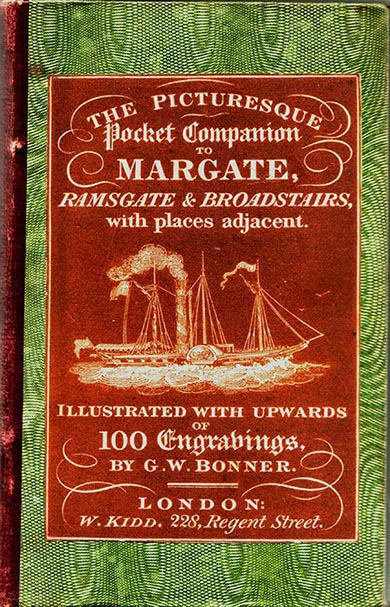The Picturesque Pocket Companion to Margate, Ramsgate and Broadstairs, and the parts adjacent: with 120 Illustrations on Wood , by G. W. Bonner was published by William Kidd of London as part of their “Picturesque” Guide series in 1831, at a price of 1s 6d. [The Athenaeum, 1832, p 152]. It was reviewed in The Literary Gazette, and Journal of the Belles Lettres in 1831 [July 9 1831, p 443] as follows:
|
The Picturesque Pocket Companion to Margate, Ramsgate and Broadstairs , and the parts adjacent: with 120 Illustrations on Wood, By G. W. Bonner, 18mo. pp. 216. London, 1831. Kidd.
This is a truly picturesque little volume of some very picturesque and beautiful scenery. Its principal recommendations are the numerous wood engravings with which it is illustrated, some of which are as delicate specimens of the art of wood-cutting, and as faithful views of the several objects, as anything we have met with in the landscape department: they are equally creditable to the skill of the artist and the taste of the publisher. The letter-press is just sufficient for the purpose intended, - briefly historical, and therefore admirably calculated for a pocket companion; while a copious Index affords instant reference for every remarkable object on the river Thames and the Isle of Thanet. We apprehend few solitary travellers, or new visitors to the Isle, will be without a " Pocket Companion.”
|

|
The woodcuts were included in Three hundred and twenty picturesque views in Great Britain by Charles MacKenzie, published by Edward Lacey, London, probably in 1835, which proclaims: “The views in this complete series are admitted to be, without exception, the prettiest as well as the most faithful delineations of the places they represent, and are quite gems of art as illustrative engravings.” They were also reprinted in 1839 in Picturesque excursions; containing upwards of four hundred views, at and near places of popular resort, etc. edited by Arthur Freeling and published by William S. Orr & Co., London. Finally, the original volume was reprinted in “An Enlarged Edition” under the title The Picturesque Companion to the Isle of Thanet by W. C. Brasier, of 20 High Street, Margate, with the same illustrations and much the same text. Although undated, this edition was published some time after the South Eastern Railway opened their line to Margate in 1846.
|
George Wilmot Bonner, the wood engraver, was born in 1796 and died in 1836. He trained two pupils who went on to obtain fame as wood engravers, William James Linton and Henry Vizetelly, who left rather different impressions of him. Linton clearly enjoyed his time working with Bonner:
“ In 1828, having taken lessons in some sort of drawing, and therefore being fondly supposed to have an artistic inclination, I was apprenticed to Mr. George Wilmot Bonner, wood-engraver, a nephew and pupil of Branston, and went to live with the Bonner family for six years at Kennington, a suburb of London on the Surrey side. Bonner was a clever artist, and a good master, making his pupils learn and do everything connected with their work, even to sawing up a box-wood log and planning and smoothing the rounds of wood to fit them to receive the drawings. For these we might also sometimes have to make the sketches and draw them on the wood for our own engraving. It was good artistic training.” [The English Republic, by W. J. Linton. With introduction and notes, by Kineton Parkes, 1891]
Vizetelly had less fond memories:
“When, in 1835, the time arrived for me to leave school, a certain aptitude I had shown for drawing led my father to think of educating me for an artist. But after I had spent a few months in copying from the flat and the round, and had attended some occasional Royal Academy lectures, wood-engraving was deemed a preferable profession for me to follow, owing to my father's position as a publisher. I was thereupon apprenticed to a friend of the family, Mr. G. W. Bonner, a second-rate wood-engraver, who intensified in his woodcuts the conventional mannerisms of the bold water-colour drawings which he was somewhat an adept at producing. . . . Bonner employed several assistants, and had one other apprentice, who, like myself, lived with the family at Newington. . . . Ten hours’ work a day was our allotted portion.” [Glances back through Seventy Years: Autobiographical and Other Reminiscences, Volume 1, Henry Vizetelly, Kegan Paul, Trench, Trubner and Co, 1893]
|

